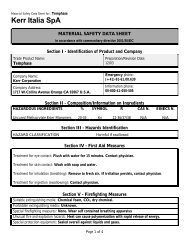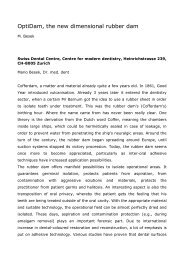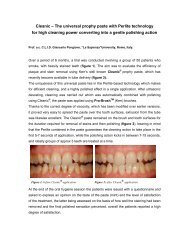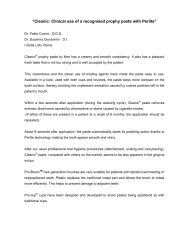Restorative Procedure - Kerr Hawe
Restorative Procedure - Kerr Hawe
Restorative Procedure - Kerr Hawe
Create successful ePaper yourself
Turn your PDF publications into a flip-book with our unique Google optimized e-Paper software.
All you need is <strong>Kerr</strong><br />
Composites<br />
<strong>Restorative</strong> <strong>Procedure</strong><br />
COMPOSITES<br />
Aesthetics and composite<br />
Prof. Angelo Putignano, University of Marche, Ancona, Italy<br />
Since the ancient Greeks great philosophers, such<br />
as Plato, Baumgarten, Kant, Hegel, Vico and Croce,<br />
have sought to place the concept of aesthetics and<br />
beauty on a rational and “scientific” basis.The triad<br />
of beauty, goodness and truth represents the ideal<br />
to which individuals should aspire in the attainment<br />
of what is called “perfection”, which perhaps does<br />
not exist. Most widely shared concepts on<br />
perceived beauty arise from interaction between<br />
“sensibility” emotional and instinctive influence,<br />
and “intellect” or rational factors. Hutchinson and<br />
Shaftesbury defined felicitously aesthetics as the<br />
aptitude for perceiving harmony (Inquiry into the<br />
origin of our ideas of beauty 1725).<br />
Cosmetics tend to be distinguished from aesthetics,<br />
which is searching for a stereotype of beauty<br />
regardless of the natural context in which the<br />
subject is placed. Aesthetics, on the other hand,<br />
would be an expression of a natural archetype<br />
in accordance with mathematical theorem, with<br />
clear and translatable principles of beauty.<br />
In this respect, an ethical inner sense of aesthetics<br />
has been theorized, defined as the passive ability<br />
to receive ideas of beauty from all objects in which<br />
there is uniformity in variety ("harmony") (1). These<br />
objective factors, which accept an interaction<br />
between the object and the “mental categories” of<br />
the observer, provide the rational basis of beauty.<br />
Numerous rules of beauty have been applied to<br />
anatomy in formulating dentofacial proportions<br />
coherent with the “golden section” (Leonardo), or<br />
in accordance with anthropometric (cephalometric)<br />
parameters adopted from epidemiological studies.<br />
However, there are a series of subjective factors<br />
peculiar to instinctive emotional and psychological<br />
context of the observer, which can significantly<br />
condition the sensitivity to beauty. Also to assimilate<br />
to “taste” and perception of beauty correlated with<br />
the epoch and specific historical, cultural and social<br />
context in which the observer inhabits. Pilkington<br />
defined dental aesthetics in 1936 as “the science of<br />
copying, harmonising our work with that of nature,<br />
seeking to minimise it as much as possible”.<br />
A few decades ago, the majority of dentists working<br />
in the field of restoration concentrated on long-term<br />
solutions and the appearance of the restorations<br />
was of secondary importance (2). Thus, in ordinary<br />
practice, restorations made of amalgam and crowns<br />
made of gold alloy were utilised as the main and<br />
most lasting solutions and patients accepted these<br />
dental restorations despite their unpleasant<br />
appearance. The evolution of preventive and<br />
conservative dentistry has had a great impact on<br />
the development of restorative aesthetic dentistry.<br />
The success of preventive dentistry has resulted<br />
in teeth without caries and therefore white and not<br />
restored, with a resulting increase in the demand<br />
for aesthetic restorations.<br />
Good appearance, together with good overall health,<br />
with adequate restoration of function, and an<br />
attractive smile play an important role in modern<br />
society. In general, a smile is beautiful when the<br />
teeth are well characterised in respect to their<br />
shape, contour, colour, surface texture and detail,<br />
emergence profile, angle and position, and incisal<br />
occlusion. The aim of every aesthetic restoration is<br />
to be credible and natural with regards to function<br />
with maximum preservation of dentition and<br />
periodontal tissues, in achieving this objective the<br />
clinician must select the most suitable materials<br />
17

















